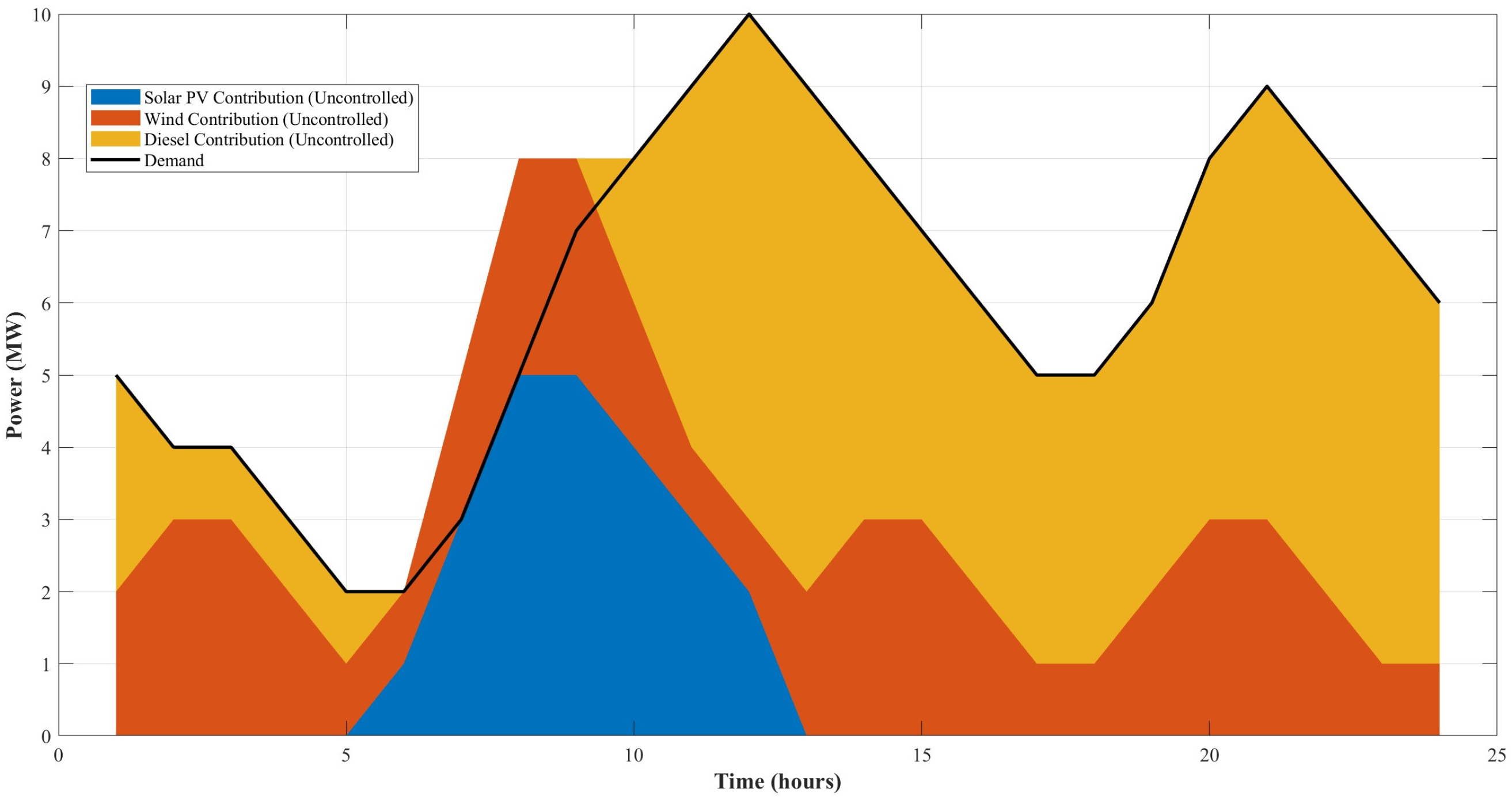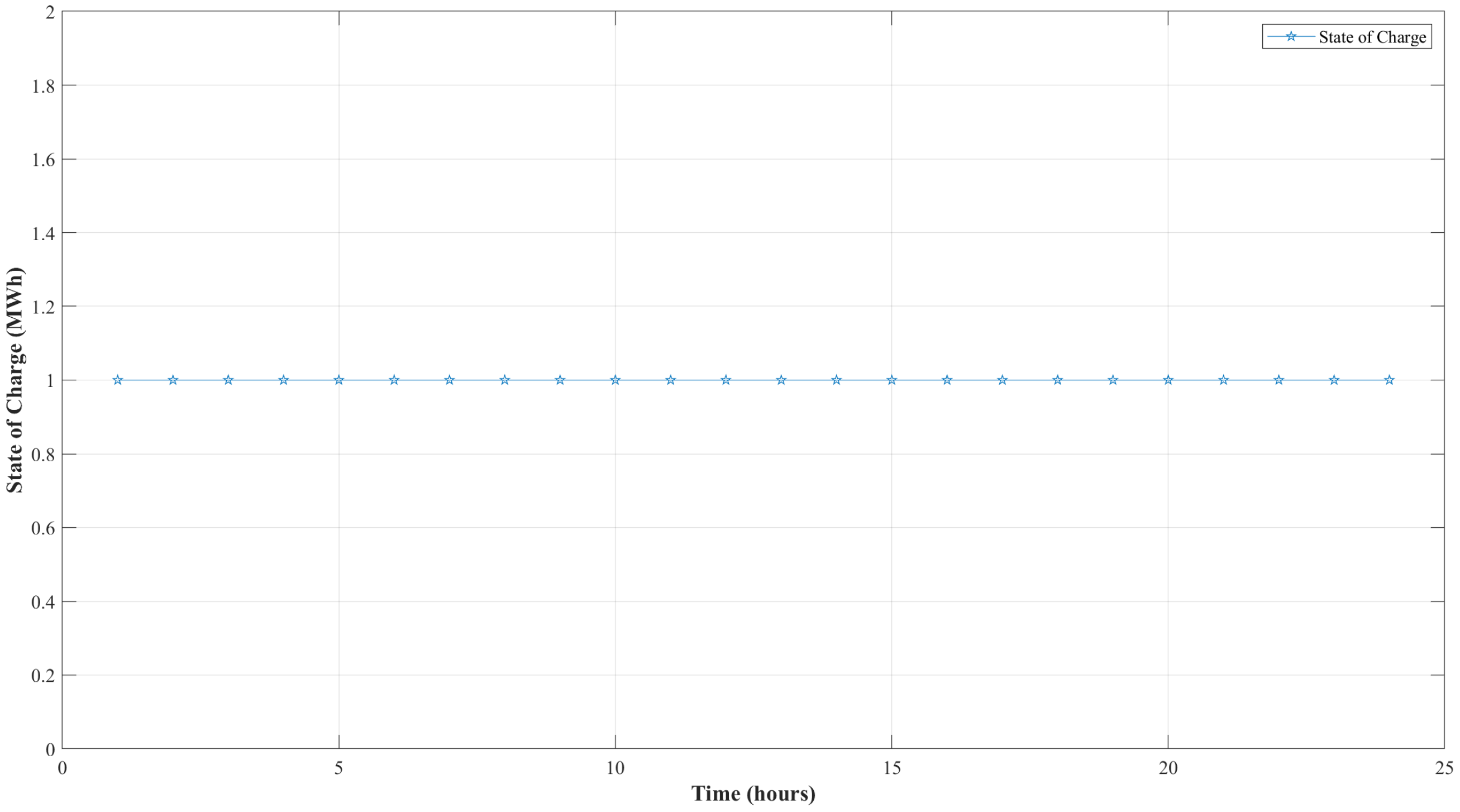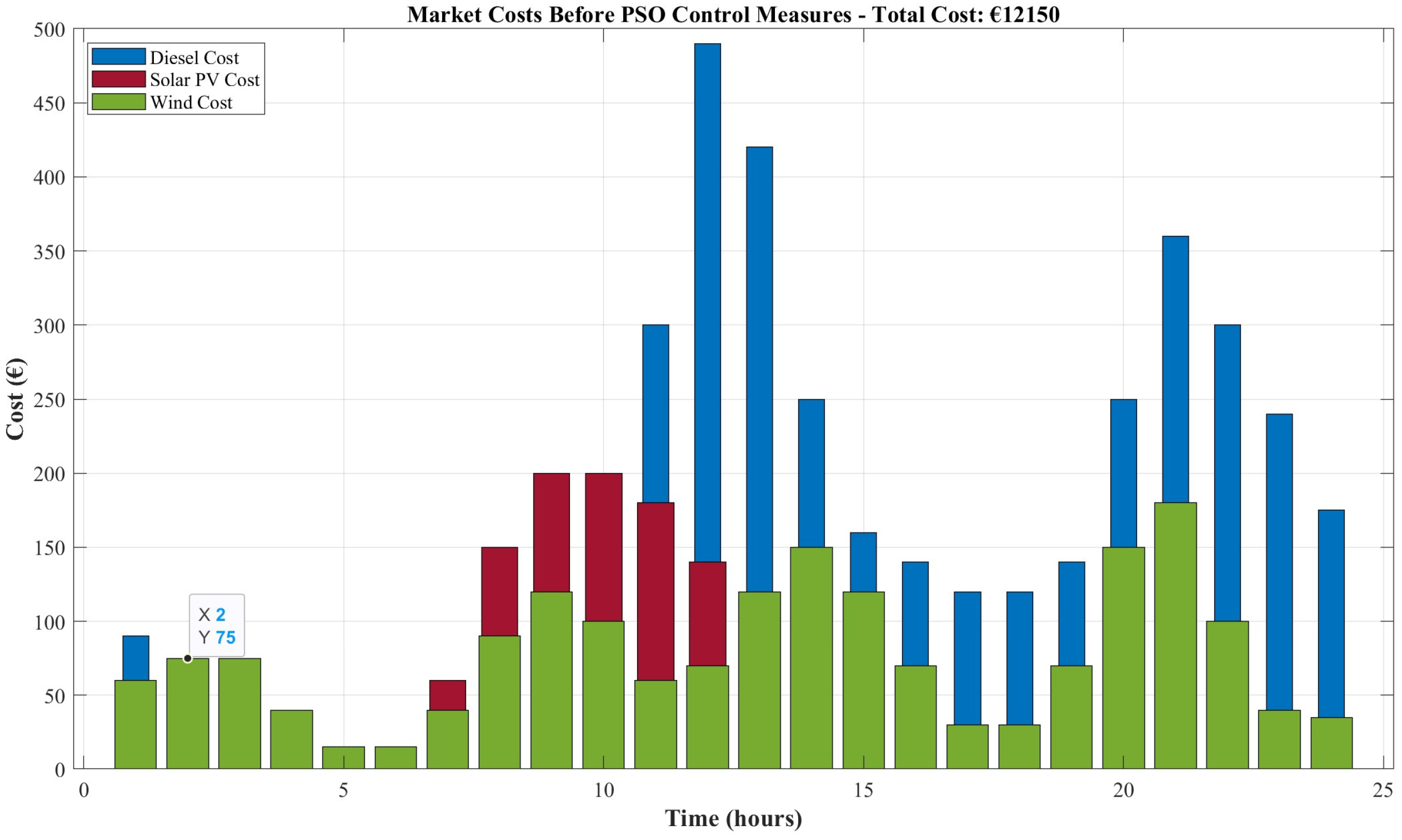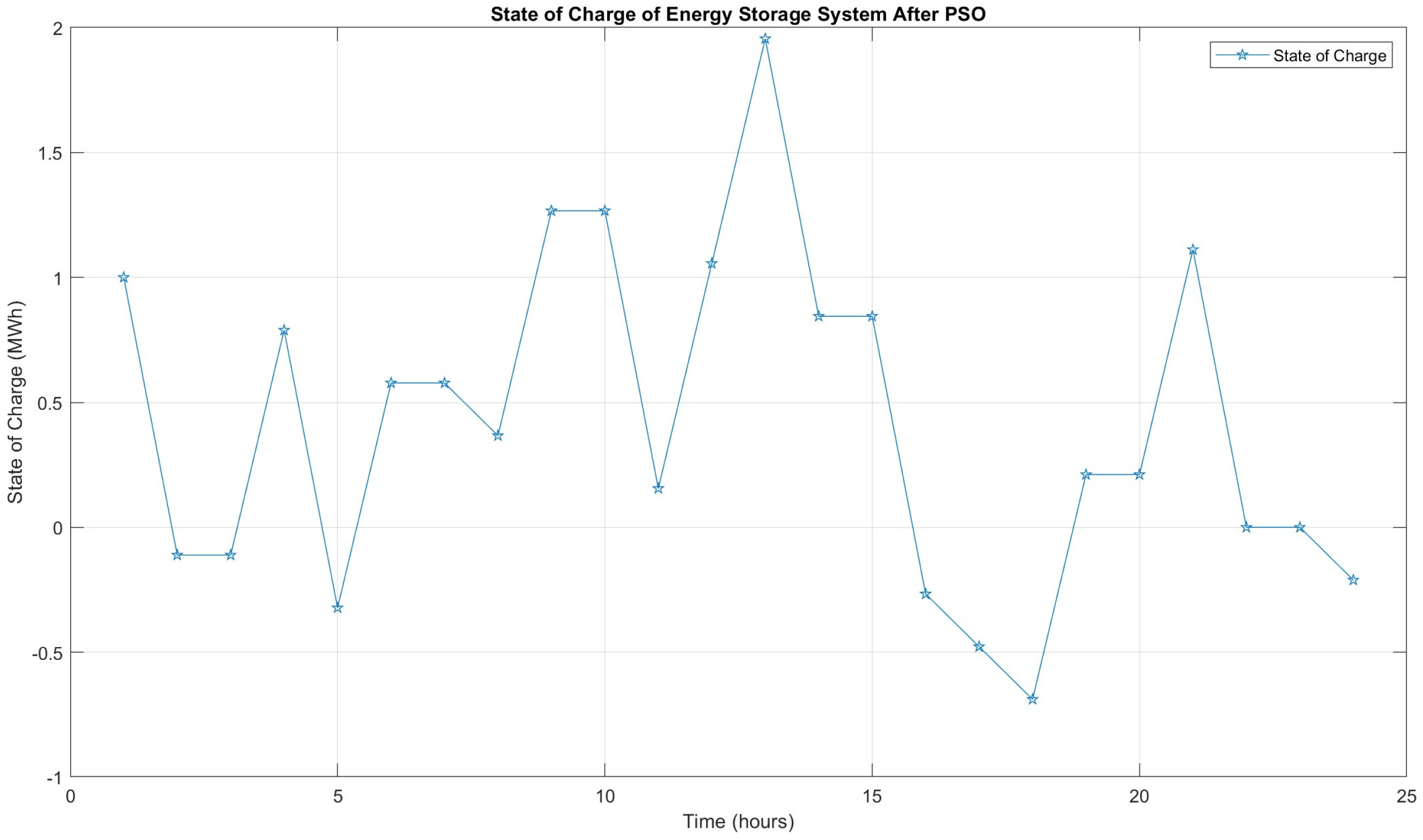Adaptive Control and Market Integration: Optimizing Distributed Power Resources for a Sustainable Grid
Abstract
1. Introduction
2. Materials and Methods
2.1. System Description and Assumptions
- Distributed power resources (DPRs): These include renewable energy sources (solar PV and wind turbines), energy storage systems (ESS), and conventional distributed generators.
- Market environment: Comprises day-ahead and real-time markets for energy and ancillary services.
- Control framework: A hierarchical control structure with primary, secondary, and tertiary control levels.
2.2. Mathematical Modeling
2.2.1. Objective Function
2.2.2. Power Balance Constraint
2.2.3. Capacity Constraints
2.2.4. Renewable Energy Constraints
2.2.5. Storage Constraints
2.2.6. Market Participation
2.2.7. Control Strategies
2.3. Implementation Steps
2.3.1. Case Study
2.3.2. Distributed Power Resources (DPRs)
2.3.3. Data Input
3. Results
3.1. System Before Optimization
3.2. MILP Optimization
- Initial total cost before MILP: EUR 12,150.
- Total cost after MILP: EUR 9383.
- Cost reduction: EUR 2767.
3.3. PSO
- Initial total cost before PSO: EUR 12,150.
- Total cost after PSO: EUR 5510.
- Cost reduction: EUR 6640.
4. Discussion
- System Before Optimization:
- MILP Optimization:
- PSO:
5. Conclusions
- Total operational costs were reduced significantly by approximately 54.7%, from EUR 12,150 before optimization to EUR 5510 after PSO implementation, highlighting PSO’s superior efficiency.
- Renewable energy utilization notably improved, with renewables consistently meeting around 60% peak demand, thereby substantially reducing reliance on diesel generation.
- Energy storage system (ESS) efficiency and effectiveness improved considerably, resulting in the optimization of the state-of-charge (SoC) management within the range of 0.3 MWh to 1.8 MWh.
Author Contributions
Funding
Data Availability Statement
Acknowledgments
Conflicts of Interest
References
- Blaabjerg, F.; Yang, Y.; Yang, D.; Wang, X. Distributed Power-Generation Systems and Protection. Proc. IEEE 2017, 105, 1311–1331. [Google Scholar]
- Parag, Y.; Sovacool, B.K. Electricity market design for the prosumer era. Nat. Energy 2016, 1, 16032. [Google Scholar] [CrossRef]
- Guerrero, J.M.; Chandorkar, M.; Lee, T.-L.; Loh, P.C. Advanced Control Architectures for Intelligent Microgrids—Part I: Decentralized and Hierarchical Control. IEEE Trans. Ind. Electron. 2013, 60, 1254–1262. [Google Scholar] [CrossRef]
- Pereira, G.I.; da Silva, P.P.; Soule, D. Policy-adaptation for a smarter and more sustainable EU electricity distribution industry: A foresight analysis. Environ. Dev. Sustain. 2018, 20, 231–267. [Google Scholar] [CrossRef]
- Olivares, D.E.; Mehrizi-Sani, A.; Etemadi, A.H.; Canizares, C.A.; Iravani, R.; Kazerani, M.; Hajimiragha, A.H.; Gomis-Bellmunt, O.; Saeedifard, M.; Palma-Behnke, R.; et al. Trends in Microgrid Control. IEEE Trans. Smart Grid 2014, 5, 1905–1919. [Google Scholar] [CrossRef]
- Blanco, C.; Paz, F.; Zurbriggen, I.G.; Garcia, P.; Ordonez, M. Distributed Islanding Detection in Multisource DC Microgrids: Pilot Signal Cancelation. IEEE Access 2022, 10, 78370–78383. [Google Scholar] [CrossRef]
- Fu, H.; Li, W.; Qiu, L.; Ai, Y.; Liu, Z. A Communication Encryption-Based Distributed Cooperative Control for Distributed Generators in Microgrids under FDI Attacks. Energies 2023, 16, 7754. [Google Scholar] [CrossRef]
- Guerrero, J.M.; Loh, P.C.; Lee, T.-L.; Chandorkar, M. Advanced Control Architectures for Intelligent Microgrids—Part II: Power Quality, Energy Storage, and AC/DC Microgrids. IEEE Trans. Ind. Electron. 2012, 60, 1263–1270. [Google Scholar] [CrossRef]
- Bin Nadeem, T.; Siddiqui, M.; Khalid, M.; Asif, M. Distributed energy systems: A review of classification, technologies, applications, and policies. Energy Strategy Rev. 2023, 48, 101096. [Google Scholar] [CrossRef]
- Casagrande, V.; Boem, F. A novel learning-based MPC with embedded profiles prediction for microgrid energy management*. IFAC-PapersOnLine 2023, 56, 7954–7959. [Google Scholar] [CrossRef]
- Zahraoui, Y.; Korõtko, T.; Rosin, A.; Mekhilef, S.; Seyedmahmoudian, M.; Stojcevski, A.; Alhamrouni, I. AI Applications to Enhance Resilience in Power Systems and Microgrids—A Review. Sustainability 2024, 16, 4959. [Google Scholar] [CrossRef]
- Yang, H.; Zhao, J.; Lam, K.-Y.; Xiong, Z.; Wu, Q.; Xiao, L. Distributed Deep Reinforcement Learning-Based Spectrum and Power Allocation for Heterogeneous Networks. IEEE Trans. Wirel. Commun. 2022, 21, 6935–6948. [Google Scholar] [CrossRef]
- Soares, T.; Silva, M.; Sousa, T.; Morais, H.; Vale, Z. Energy and Reserve under Distributed Energy Resources Management—Day-Ahead, Hour-Ahead and Real-Time. Energies 2017, 10, 1778. [Google Scholar] [CrossRef]
- Gulotta, F.; Daccò, E.; Bosisio, A.; Falabretti, D. Opening of Ancillary Service Markets to Distributed Energy Resources: A Review. Energies 2023, 16, 2814. [Google Scholar] [CrossRef]
- Azar, B.M.; Mohammadian-Alirezachaei, H.; Kazemzadeh, R. Transactive Energy and Peer-to-Peer Trading Applications in Energy Systems: An Overview. In Demand-Side Peer-to-Peer Energy Trading. Green Energy and Technology; Vahidinasab, V., Mohammadi-Ivatloo, B., Eds.; Springer: Cham, Switzerland, 2023. [Google Scholar] [CrossRef]
- Su, W.; Huang, A.Q. A game theoretic framework for a next-generation retail electricity market with high penetration of distributed residential electricity suppliers. Appl. Energy 2014, 119, 341–350. [Google Scholar] [CrossRef]
- Brown, M.A.; Zhou, S.; Ahmadi, M. Smart grid governance: An international review of evolving policy issues and innovations. WIREs Energy Environ. 2018, 7, e290. [Google Scholar] [CrossRef]
- Bhatia, T.; Bharathy, G.; Prasad, M. A Targeted Review on Revisiting and Augmenting the Framework for Technology Acceptance in the Renewable Energy Context. Energies 2024, 17, 1982. [Google Scholar] [CrossRef]
- Mohamed, A.-A.A.; Ali, S.; Alkhalaf, S.; Senjyu, T.; Hemeida, A.M. Optimal Allocation of Hybrid Renewable Energy System by Multi-Objective Water Cycle Algorithm. Sustainability 2019, 11, 6550. [Google Scholar] [CrossRef]
- da Costa, V.B.F.; de Doile, G.N.D.; Troiano, G.; Dias, B.H.; Bonatto, B.D.; Soares, T.; Filho, W.d.F. Electricity Markets in the Context of Distributed Energy Resources and Demand Response Programs: Main Developments and Challenges Based on a Systematic Literature Review. Energies 2022, 15, 7784. [Google Scholar] [CrossRef]
- Zhang, G.; Wang, W.; Du, J.; Sheng, H. Multiobjective Economic Optimal Dispatch for the Island Isolated Microgrid under Uncertainty Based on Interval Optimization. Math. Probl. Eng. 2021, 2021, 9983104. [Google Scholar] [CrossRef]
- Tightiz, L.; Yang, H.; Piran, M.J. A Survey on Enhanced Smart Micro-Grid Management System with Modern Wireless Technology Contribution. Energies 2020, 13, 2258. [Google Scholar] [CrossRef]
- Morstyn, T.; Collett, K.A.; Vijay, A.; Deakin, M.; Wheeler, S.; Bhagavathy, S.M.; Fele, F.; McCulloch, M.D. OPEN: An open-source platform for developing smart local energy system applications. Appl. Energy 2020, 275, 115397. [Google Scholar] [CrossRef]
- Liu, J.; Hu, H.; Yu, S.S.; Trinh, H. Virtual Power Plant with Renewable Energy Sources and Energy Storage Systems for Sustainable Power Grid-Formation, Control Techniques and Demand Response. Energies 2023, 16, 3705. [Google Scholar] [CrossRef]
- Kumar, A.; Meena, N.K.; Singh, A.R.; Deng, Y.; He, X.; Bansal, R.; Kumar, P. Strategic integration of battery energy storage systems with the provision of distributed ancillary services in active distribution systems. Appl. Energy 2019, 253, 113503. [Google Scholar] [CrossRef]
- Zhao, J.; Wang, C.; Zhao, B.; Lin, F.; Zhou, Q.; Wang, Y. A Review of Active Management for Distribution Networks: Current Status and Future Development Trends. Electr. Power Components Syst. 2014, 42, 280–293. [Google Scholar] [CrossRef]
- Agbonaye, O.; Keatley, P.; Huang, Y.; Mustafa, M.B.; Hewitt, N. Design, Valuation and Comparison of Demand Response Strategies for Congestion Management. Energies 2020, 13, 6085. [Google Scholar] [CrossRef]
- Le, T.T.; Paramasivam, P.; Adril, E.; Nguyen, V.Q.; Le, M.X.; Duong, M.T.; Le, H.C.; Nguyen, A.Q. Unlocking renewable energy potential: Harnessing machine learning and intelligent algorithms. Int. J. Renew. Energy Dev. 2024, 13, 783–813. [Google Scholar] [CrossRef]
- Martínez, J.-F.; Rodríguez-Molina, J.; Castillejo, P.; De Diego, R. Middleware Architectures for the Smart Grid: Survey and Challenges in the Foreseeable Future. Energies 2013, 6, 3593–3621. [Google Scholar] [CrossRef]
- Park, K.T.; Son, Y.H.; Noh, S.D. The architectural framework of a cyber physical logistics system for digital-twin-based supply chain control. Int. J. Prod. Res. 2020, 59, 5721–5742. [Google Scholar] [CrossRef]
- Li, S.; Oshnoei, A.; Blaabjerg, F.; Anvari-Moghaddam, A. Hierarchical Control for Microgrids: A Survey on Classical and Machine Learning-Based Methods. Sustainability 2023, 15, 8952. [Google Scholar] [CrossRef]
- Qi, J.; Hahn, A.; Lu, X.; Wang, J.; Liu, C. Cybersecurity for distributed energy resources and smart inverters. IET Cyber-Physical Syst. Theory Appl. 2016, 1, 28–39. [Google Scholar] [CrossRef]
- Mahmud, M.P.; Farjana, S.H. Comparative Life Cycle Environmental Impact Assessment of Renewable Electricity Generation Systems: A Practical Approach Towards Europe, North America and Oceania. Renew. Energy 2022, 193, 1106–1120. [Google Scholar] [CrossRef]
- Agarwal, U.; Jain, N. Distributed Energy Resources and Supportive Methodologies for their Optimal Planning under Modern Distribution Network: A Review. Technol. Econ. Smart Grids Sustain. Energy 2019, 4, 3. [Google Scholar] [CrossRef]
- Yigitcanlar, T.; Kamruzzaman, M. Planning, Development and Management of Sustainable Cities: A Commentary from the Guest Editors. Sustainability 2015, 7, 14677–14688. [Google Scholar] [CrossRef]
- Economic and Social Commission for Asia and the Pacific. Systematic Review of the Socio-Economic Impacts of Rural Electrification. 2021. Available online: https://repository.unescap.org/rest/bitstreams/097a490e-ea41-4f36-bca4-7d83806622a1/retrieve (accessed on 20 March 2025).
- Yuan, X.; Jiao, X.; Wang, M.; Han, H.; Lv, S.; Zeng, F. Pricing Strategies for Distribution Network Electric Vehicle Operators Considering the Uncertainty of Renewable Energy. Processes 2024, 12, 1230. [Google Scholar] [CrossRef]
- Hinz, H. Comparison of Lithium-Ion Battery Models for Simulating Storage Systems in Distributed Power Generation. Inventions 2019, 4, 41. [Google Scholar] [CrossRef]
- Reddy, G.P.; Kumar, Y.V.P.; Chakravarthi, M.K. Communication Technologies for Interoperable Smart Microgrids in Urban Energy Community: A Broad Review of the State of the Art, Challenges, and Research Perspectives. Sensors 2022, 22, 5881. [Google Scholar] [CrossRef] [PubMed]
- Zhang, Y.; Huang, T.; Bompard, E.F. Big data analytics in smart grids: A review. Energy Inform. 2018, 1, 8. [Google Scholar] [CrossRef]
- Xiong, Z.; Zhang, D.; Wang, Y. Optimal operation of integrated energy systems considering energy trading and integrated demand response. Energy Rep. 2024, 11, 3307–3316. [Google Scholar] [CrossRef]
- Sharma, K.C.; Jain, P.; Bhakar, R. Wind Power Scenario Generation and Reduction in Stochastic Programming Framework. Electr. Power Compon. Syst. 2013, 41, 271–285. [Google Scholar] [CrossRef]
- Li, R.; Wu, Q.; Oren, S.S. Distribution Locational Marginal Pricing for Optimal Electric Vehicle Charging Management. IEEE Trans. Power Syst. 2013, 29, 203–211. [Google Scholar] [CrossRef]
- Zhang, H.; Zhan, S.; Kok, K.; Paterakis, N.G. Hybrid Local Electricity Market Designs with Distributed and Hierarchical Structures. In Proceedings of the 2023 IEEE Belgrade PowerTech, Belgrade, Serbia, 25–29 June 2023; pp. 01–06. [Google Scholar]
- Xu, Y.; Han, J.; Yin, Z.; Liu, Q.; Dai, C.; Ji, Z. Voltage and Reactive Power-Optimization Model for Active Distribution Networks Based on Second-Order Cone Algorithm. Computers 2024, 13, 95. [Google Scholar] [CrossRef]
- Götz, M.; Lefebvre, J.; Mörs, F.; McDaniel Koch, A.; Graf, F.; Bajohr, S.; Reimert, R.; Kolb, T. Renewable Power-to-Gas: A technological and economic review. Renew. Energy 2016, 85, 1371–1390. [Google Scholar] [CrossRef]
- Sodiya, E.O.; Umoga, U.J.; Obaigbena, A.; Jacks, B.S.; Ugwuanyi, E.D.; Daraojimba, A.I.; Lottu, O.A. Current state and prospects of edge computing within the Internet of Things (IoT) ecosystem. Int. J. Sci. Res. Arch. 2024, 11, 1863–1873. [Google Scholar] [CrossRef]
- Gohar, O.; Khan, M.Z.; Bibi, I.; Bashir, N.; Tariq, U.; Bakhtiar, M.; Karim, M.R.A.; Ali, F.; Hanif, M.B.; Motola, M. Nanomaterials for advanced energy applications: Recent advancements and future trends. Mater. Des. 2024, 241, 112930. [Google Scholar] [CrossRef]









Disclaimer/Publisher’s Note: The statements, opinions and data contained in all publications are solely those of the individual author(s) and contributor(s) and not of MDPI and/or the editor(s). MDPI and/or the editor(s) disclaim responsibility for any injury to people or property resulting from any ideas, methods, instructions or products referred to in the content. |
© 2025 by the authors. Licensee MDPI, Basel, Switzerland. This article is an open access article distributed under the terms and conditions of the Creative Commons Attribution (CC BY) license (https://creativecommons.org/licenses/by/4.0/).
Share and Cite
Otshwe, J.N.; Li, B.; Chen, S.; Gong, F.; Qi, B.; Chabrol, N.J. Adaptive Control and Market Integration: Optimizing Distributed Power Resources for a Sustainable Grid. Energies 2025, 18, 1658. https://doi.org/10.3390/en18071658
Otshwe JN, Li B, Chen S, Gong F, Qi B, Chabrol NJ. Adaptive Control and Market Integration: Optimizing Distributed Power Resources for a Sustainable Grid. Energies. 2025; 18(7):1658. https://doi.org/10.3390/en18071658
Chicago/Turabian StyleOtshwe, Josue N., Bin Li, Songsong Chen, Feixiang Gong, Bing Qi, and Ngouokoua J. Chabrol. 2025. "Adaptive Control and Market Integration: Optimizing Distributed Power Resources for a Sustainable Grid" Energies 18, no. 7: 1658. https://doi.org/10.3390/en18071658
APA StyleOtshwe, J. N., Li, B., Chen, S., Gong, F., Qi, B., & Chabrol, N. J. (2025). Adaptive Control and Market Integration: Optimizing Distributed Power Resources for a Sustainable Grid. Energies, 18(7), 1658. https://doi.org/10.3390/en18071658






